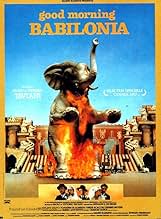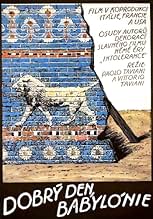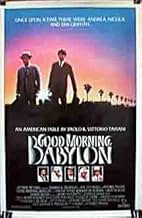CALIFICACIÓN DE IMDb
6.7/10
1.8 k
TU CALIFICACIÓN
Cuando el negocio familiar falla, dos hermanos emigran a América para restaurar su fortuna. La vida les sonríe en Hollywood, hasta que la primera guerra mundial estalla, y ambos hermanos aca... Leer todoCuando el negocio familiar falla, dos hermanos emigran a América para restaurar su fortuna. La vida les sonríe en Hollywood, hasta que la primera guerra mundial estalla, y ambos hermanos acaban luchando en bandos opuestos.Cuando el negocio familiar falla, dos hermanos emigran a América para restaurar su fortuna. La vida les sonríe en Hollywood, hasta que la primera guerra mundial estalla, y ambos hermanos acaban luchando en bandos opuestos.
- Dirección
- Guionistas
- Elenco
- Premios
- 3 premios ganados y 1 nominación en total
Désirée Nosbusch
- Mabel Bonnano
- (as Desiree Becker)
Opiniones destacadas
the last scene was the key to enter the whole fact of the film. Two brothers in 2 fronts against eachother, but the brother from US holds his hands up to show he is defeated by the other brother. But the film tells us why it shows us these brothers story: FILM...which makes people eternal on the celluloids. It shows us people in different centuries who worked on that church but the only ones whom we know are these brothers, because they curved themselves on the film which was in a camera around. Wow, the Film was softly striking... I wanted not to watch at first, but the first scene grabbed my heart and make me stay to watch it completely...
Story has two Italian brothers who are stonemasons going to America and eventually finding themselves in California where they eventually find work as part of the team that builds the Italian Towers and the Tower of Jewels for the Panama-Pacific International Exposition in San Francisco in 1915.
When legendary movie maker D.W. Griffith sees the film CABIRIA and the exposition lit by searchlights he calls for the Italians to come to Hollywood. He has a grand idea for a film he's making. The films is INTOLERANCE.
The brothers finally break through the bureaucracy surrounding Griffith and design the gigantic elephants and other designs for the massive Babylonian sets for the film. Along the way they marry movie extras and settle into a successful life as artisans in Hollywood. Then comes World War I.
The film by the Taviani brothers has a dreamlike quality that blurs the line between fact and fiction. While Griffith (played by Charles Dance) is front and center in the Hollywood segments, his wife, Linda Arvidson, is never mentioned by name nor is cameraman Billy Bitzer. Aside from Griffith, no real person in Hollywood is mentioned by name.
Vincent Spano and Joaquim de Almeida are fine as the Italian brothers, and Greta Scacchi is good as the doomed wife.
After all the hubbub about INTOLERANCE and much time spent on the building of the sets, there's only a very brief clip from the real film shown.
When legendary movie maker D.W. Griffith sees the film CABIRIA and the exposition lit by searchlights he calls for the Italians to come to Hollywood. He has a grand idea for a film he's making. The films is INTOLERANCE.
The brothers finally break through the bureaucracy surrounding Griffith and design the gigantic elephants and other designs for the massive Babylonian sets for the film. Along the way they marry movie extras and settle into a successful life as artisans in Hollywood. Then comes World War I.
The film by the Taviani brothers has a dreamlike quality that blurs the line between fact and fiction. While Griffith (played by Charles Dance) is front and center in the Hollywood segments, his wife, Linda Arvidson, is never mentioned by name nor is cameraman Billy Bitzer. Aside from Griffith, no real person in Hollywood is mentioned by name.
Vincent Spano and Joaquim de Almeida are fine as the Italian brothers, and Greta Scacchi is good as the doomed wife.
After all the hubbub about INTOLERANCE and much time spent on the building of the sets, there's only a very brief clip from the real film shown.
10mbgeorge
The film is historical and quite moving, encapsulating the experience of Italian Immigrants adjusting to a new life in the New World. The two brothers, and other characters, are well-developed. The film has excellent timing, breathtaking cinematography and a gripping storyline.
1st watched 1/19/1997 - (Dir-Paolo Tavioni & Vittorio Tavioni): Good story and interesting characters. About two inseparable brothers and their encounters when coming to America in the early 1900's and their way into a D.W. Griffith movie.
A drama by Taviani brothers. Although the depressing poverty and brutality against animals, core elements in their harsh "Padre Padrone", were also present in "Good morning, Babylon", the latter is, most of the time, a light-hearted film, until the sad resume. Their adventures in Hollywood amuse. Something intereeting tonbe renarked is that Charles Dance was able to make us be sympathetic to Grifitth (off course that fact that he was directing "Intolerance" and not "The birth of a nation" helps).
¿Sabías que…?
- TriviaThe epic silent movie that director D.W. Griffith was making in this film was Intolerancia (1916).
- ErroresThe director D.W. Griffith is sat into his car and looking outside the right window, attracted by the Italian Pavillion of the Universal Expo in San Francisco. He asks the driver to stop, gets down, walks around the car and, on the left side, looks again towards the Pavillion (that should have been on the right side)
- Citas
D.W. Griffith: Never mind. Artists communicate through their work.
- ConexionesFeatures Intolerancia (1916)
- Bandas sonorasLa Gazza Ladra - Sinfonia
Composed by Gioachino Rossini
Libretto by Giovanni Gherardini [based on "La pie voleuse" by Théodore Baudouin d'Aubigny and Louis-Charles Caigniez ]
Selecciones populares
Inicia sesión para calificar y agrega a la lista de videos para obtener recomendaciones personalizadas
- How long is Good Morning Babylon?Con tecnología de Alexa
Detalles
Taquilla
- Total en EE. UU. y Canadá
- USD 183,700
- Fin de semana de estreno en EE. UU. y Canadá
- USD 24,569
- 19 jul 1987
- Total a nivel mundial
- USD 183,700
Contribuir a esta página
Sugiere una edición o agrega el contenido que falta



















